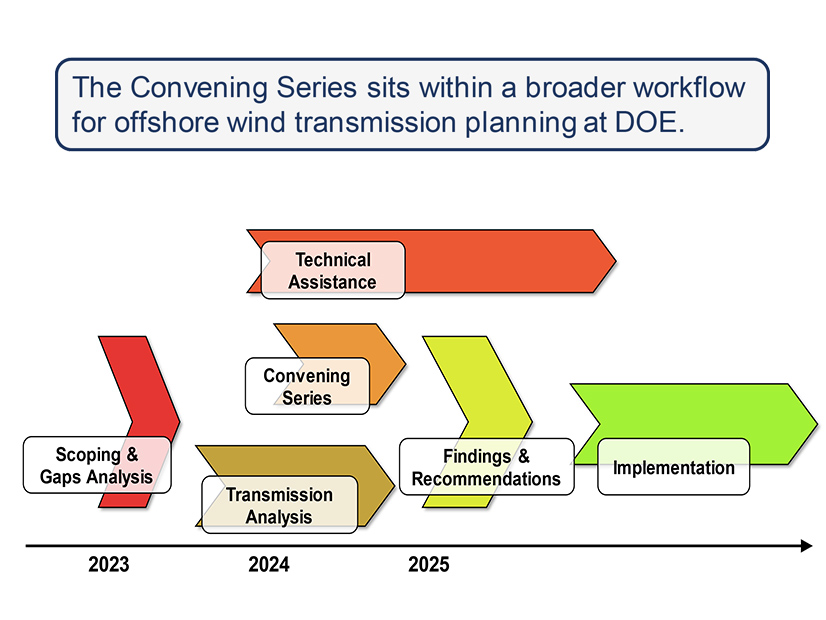
The DOE and BOEM launched a series of stakeholder workshops to address the specific challenges to siting transmission for the first generation of West Coast offshore wind projects.
The U.S. Department of Energy and Bureau of Ocean Energy Management on Jan. 17 kicked off a series of stakeholder workshops to address the specific challenges to siting transmission for the first generation of West Coast offshore wind projects.
Agency representatives said the meetings aren’t intended to produce siting or regulatory decisions, but to establish a set of recommendations and actions for publication as an addendum to the Atlantic Offshore Wind Transmission Action Plan, released in 2023. (See Feds Release Road Map for Offshore Transmission Grid.)
The Biden administration set a goal of deploying 30 GW of offshore wind in U.S. waters by 2030 and an additional 15 GW of floating offshore wind — the type needed in the deeper waters off the Pacific Coast — by 2035.
Speaking during the Jan. 17 virtual meeting, Jocelyn Brown-Saracino, offshore wind energy lead at DOE, highlighted that the U.S. now has a combined potential capacity of approximately 52 GW of offshore wind, up nearly 50% from three years ago. And in the last year, she noted, the global floating offshore wind pipeline grew from around 60 GW to about 103 GW.
Planners are looking to the West to accelerate that progress: California has established a goal of deploying 25 GW of offshore wind by 2045, and Oregon set a target of 3 GW by 2030.
But the West Coast currently lacks the transmission infrastructure to meet those goals. And while the Atlantic Offshore Wind action plan serves as a road map for planning in the Pacific, development along the West’s more remote coastlines comes with its own unique obstacles.
“We know that bringing this energy to shore poses a host of challenges,” said BOEM Director Liz Klein. “On the West Coast, the lack of off- and onshore transmission pathways to access offshore wind development and the harsh ocean energy environment [are challenges]. We need to work together to understand these challenges and to identify potential solutions.”
Another challenge lies in the complications of developing transmission that extends beyond a federal lease area. BOEM’s authority over transmission siting starts at the outer continental shelf, allowing the agency to grant easements and rights-of-way for the production, transmission and transportation of energy sources. But BOEM does not have jurisdiction over landfall sites, so a project developer must work with regional and state entities and utilities to determine the appropriate points of interconnection.
In convening the workshops, the agencies hope that engaging states, transmission operators, tribal nations, ocean users and others will foster collaboration for the development of offshore wind. The series is part of a broader effort, and DOE is finalizing the scoping phase and beginning technical analysis.
Scoping in early 2023 identified gaps in planning, including the need for more interregional coordination and collaboration with tribal governments. DOE is working with the National Renewable Energy Laboratory (NREL) to engage tribes through the Tribal Nation Offshore Wind Transmission Technical Assistance Program, which will offer educational resources, training, technical assistance and funding for participation.
Technical Progress
The effort will also get significant technical support from U.S. national laboratories. Last May, the Pacific Northwest National Laboratory (PNNL) and NREL launched the West Coast Offshore Wind Transmission Study, which over the span of 20 months will explore transmission options to support offshore wind development through 2050. The labs reviewed 13 technical studies on offshore wind development, identified key themes in the region and determined that coastal interconnection points lack existing capacity for integrating offshore wind.
Mark Severy, a PNNL adviser to DOE, also identified gaps in the body of work reviewed, finding that most studies were focused on a single region or state and lacked consensus on the optimal technology or topology for offshore grid infrastructure.
According to Travis Douville, wind systems integration portfolio manager at PNNL, the study is the first of its kind to assess the entire West Coast. It considers a variety of guiding questions, including how much offshore wind should be developed through 2050 and where, and lays out nine tasks designed to help answer those questions.
To determine where transmission is needed, task two identified a series of zonal capacity expansion targets that span the Western Interconnection and provide information on how much offshore wind could be brought online. The targets will then be used to build nodal representations to simulate information on the economic dispatch of individual generators and model various sensitivities such as weather.
Tasks three and four involve the consideration of various siting conflicts, such as ocean co-use and topology. Douville said Pacific coastline is particularly challenging due to the depth of the water and the contour of the sea floor and canyons.
The team is constructing four topology sets to help consider where projects should be built. With those in place, the researchers will conduct weather-synchronized simulations of historical and future load, wind and solar patterns to provide insights into the types and location of needed generation.
After the modeling is complete, the labs will quantify the changes to capital and production cost, emissions, resource adequacy and resilience characteristics to the system, as well as the socioeconomic impacts and benefits to coastal and ocean co-use communities.
Lessons Learned
Alissa Baker, senior technical adviser for offshore transmission with DOE’s Grid Deployment Office, discussed lessons learned from developing the Atlantic action plan.
“We’re not inventing the wheel from scratch here,” Baker said. “We’re starting with a plan and hopefully refining and learning from the things that went well and the things that could go even better here.”
Key among the insights, Baker emphasized the importance of partnerships, particularly among state and regional entities and with tribes. She also highlighted the need for greater interregional offshore topology planning that spans ISO, RTO and state boundaries.
Baker’s presentation noted that FERC Order 1000 “sets forth the current generic federal requirements for considering potential interregional transmission” but requires only “coordination” between regions. “Fully integrated interregional planning is allowed but not required and, to date, has not been successfully implemented for any large-scale infrastructure,” it said.
Baker also suggested updating NERC standards for offshore wind generation to ensure they’re applicable to ocean transmission infrastructure and offshore wind generation tie-lines.
Another key recommendation was the support of local communities through community benefit agreements between project developers and those impacted.
“We want to make sure that the communities that are impacted by infrastructure are benefiting from that infrastructure and that the benefit is something that is greater than the impact they’re perceiving,” she said.
The Jan. 17 meeting closed with a lighthearted prerecorded discussion between DOE Deputy Secretary David Turk and Laura Daniel-Davis, acting deputy secretary at the Department of the Interior, which oversees BOEM.
“The Biden-Harris administration has an ambitious goal of deploying 30 GW of offshore wind by 2030,” Daniel-Davis said. “When we get there, that’s enough to power 10 million homes and we’re going to cut 78 million metric tons of carbon pollution … all while we build a domestic supply chain, creating these good-paying union jobs, and we’re lowering consumers’ energy prices.”
Turk reflected on the Atlantic convening series workshops and their benefit to transmission planning in the West.
“It was an incredibly good forum, and I think the West Coast can do an even better job of these kinds of discussions going forward,” he said.

